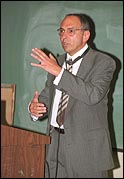Probing life beyond Earth
| Rumours the sky may one day be falling aren't entirely exaggerated according to world-renowned amateur astronomer and former McGill student David Levy. With countless village-sized comets orbiting space every year, there's always a chance that one might collide with Earth at some point in time.
 David Levy
David Levy
PHOTO: OWEN EGAN | |
"It's more than a possibility; it's definite. We just don't know when it will happen and how," Levy told about 200 people at the Frank Dawson Adams auditorium last Thursday during a talk entitled "More Things in Heaven and Earth: Speculation on Life in the Universe" that was part of a new astrobiology lecture series at McGill.
But Levy comforted his audience by saying the chances of comets hitting our planet are, thankfully, remote. "The odds are about the same as dying in a plane crash," he explained, noting that many factors in our universe protect our planet, Jupiter being one of them. "Jupiter is clobbered by comets every few years," he said. The giant planet's powerful gravitational pull makes it "a Hoover that cleans up our solar system."
It was during such a collision on Jupiter on July 16, 1994, that Levy became world-famous along with astronomers Eugene and Carolyn Shoemaker. Using a telescope and computer technology, the trio were able to track a comet — named Shoemaker-Levy 9 in honour of its discoverers — as it plunged to the gassy planet's surface, 500 million miles away from Earth.
Shoemaker-Levy 9 was one of 21 comets and several asteroids Levy has discovered since beginning his search for such objects in 1959. He's been busy popularizing astronomy ever since, beginning with a science column that he wrote for the McGill Daily while studying at the University in 1967-68. Today, he contributes to Sky and Telescope magazine, is science editor of Parade magazine and has authored 13 books on astronomy.
Now residing in Vail, Arizona, Levy is senior instructional specialist (Artist program) at the University of Arizona, an adjunct scientist at the Flandrau Planetarium and an observer with the Palomar Asteroid and Comet Survey. All this without ever taking a single course on his beloved subject, which he often studies with the help of his back-yard telescope, he said where he's "seen as far as 11 million light years away."
While it's uncertain whether comets will eventually crash onto earth, Levy said, there is evidence that small debris from various comets, including Halley's discovered by others in 1986, falls onto our planet about twice a year. He said Earth itself and the eight other planets of our solar system may even have been comets at one point that separated into nine worlds during what scientists have dubbed the Big Bang, 3.9 billion years ago.
There's also evidence, he said, that one or several comets hit Earth millions of years ago, and vaporized 75 per cent of life, including dinosaurs. These comets cleared the way for new life to emerge and for the remaining 25 per cent of species, mostly hibernating mammals, to evolve freely.
Earth, he said, retains a small scar from comet crashes called the boundary layer, which circles the entire planet. "It's as thin as a postage stamp," he said. "You wouldn't notice it unless you were looking for it, since it is sandwiched between [layers of rock]."
The boundary layer was formed as comet dust rose into the atmosphere and fell back to Earth. Levy said that comet debris, which contained new materials from outer space, somehow contained elements that allowed the birth of the human race. "Comets are remarkably made up of the same things we are," he said, including a high percentage of water. One comet, he added, "can have enough water to fill our oceans 20 times over."
Materials found in comets are so comparable to human life, he kidded, "that if you took a comet, infused it with DNA, and put a baseball cap onto it, it could easily play in the World Series." Knowing that humans were derived from particles that originated from outer space, fascinates Levy. "Each of you is made up of little pieces of sky," he reminded his audience. "You have star stuff in you."
Unfortunately, if a comet like Shoemaker-Levy 9 had hurled towards Earth, instead of Jupiter, humans would have been powerless to stop it. "Our present technology could have done nothing to prevent it from hitting us," Levy said, adding that his discovery crashed onto Jupiter at 150,000 miles per hour and had the strength of several Hiroshima-like atomic bombs set off every second for five years.
But Shoemaker-Levy 9 did provide promise; scientists now have a pattern on how comets work that may help future generations discover ways to divert these objects from Earth's path. "We learned a lesson and all nature asked us to do is watch," he said.
Levy veered off frightening tales of colliding comets by stressing humans have a much better chance of discovering other life forms in outer space. "I think one of the great discoveries of this new millennium will be that we are not alone," he said, adding that with an estimated 200 million suns scattered across the galaxy it's not unreasonable to hope that other planets may contain life similar to Earth's.
The question isn't whether or not life exists beyond our universe but rather, "how many civilizations are out there." Quoting William Shakespeare, Levy added, "There are more things in heaven and earth than any of us ever dreamed of."

